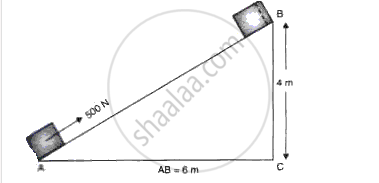Advertisements
Advertisements
प्रश्न
Mention whether work is done or not in the following activity.
| S. No | Activity | Work done or not done |
| 1. | Pushing the door | |
| 2. | Holding a doll | |
| 3. | Sitting in a bus | |
| 4. | Pushing a wall | |
| 5. | Digging soil |
उत्तर
| S. No | Activity | Work done or not done |
| 1. | Pushing the door | Work done |
| 2. | Holding a doll | Not done |
| 3. | Sitting in a bus | Not done |
| 4. | Pushing a wall | Not done |
| 5. | Digging soil | Work done |
APPEARS IN
संबंधित प्रश्न
An object thrown at a certain angle to the ground moves in a curved path and falls back to the ground. The initial and the final points of the path of the object lie on the same horizontal line. What is the work done by the force of gravity on the object?
A coolie is moving on a road with a luggage on his head. Does he perform work against the force of gravity? Give reason for your answer.
Define the term energy.
A boy weighing 25 kgf climbs up from the first floor at height 3 m above the ground to the third floor at height 9m above the ground. What will be the increase in his gravitational potential energy? (Take g = 10 N kg -1)
A bullet of mass 0.5 kg slows down from a speed of 5 m s-1 to that of 3 m s-1. Calculate the change in kinetic energy of the ball.
Write the formula for work done on a body when the body moves at an angle to the direction of force. Give the meaning of each symbol used.
Give one example each in which a force does (a) positive work (b) negative work, and (c) zero work.
If the work done by a force in moving an object through a distance of 20 cm is 24.2 J, what is the magnitude of the force?
State the conditions of equilibrium for a rigid body.
What do you mean by a kilo joule?
How many joules are there in 1 mega joule?
(a) Define power and name its unit.
(b) A girl weighting 50 kg climbs up 60 steps each of 20 cm height in 5 minutes. Calculate the power developed.
A block of mass 20 kg is pulled up a slope (fig.12) with a constant speed by applying a force of 500 N parallel to the slope. A and B are initial and final positions of the block.
(a) Calculate the work done by the force in moving the block from A and B.
(b) Calculate the potential energy gained by the block.

What do you understand by 'potential energy' and 'Kinetic energy'? Give three examples of each to illustrate your answer.
A bullet is of mass 'm' g and is moving with a velocity 'v' m/s. Find the kinetic energy of the bullet when
(a) The mass is doubled,
(b) The velocity is tripled.
Who is the odd one out?
